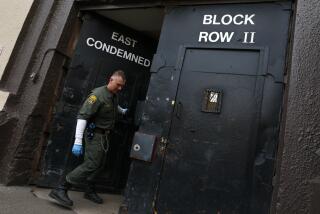President Calls for Increase in Anti-Drug Funds
President Bush, declaring “real progress” in the fight against illicit narcotics, on Monday unveiled a drug strategy that calls for increased spending to attack both demand and supply but proposes scant change in direction.
As evidence of the progress, the Administration released an authoritative survey that found the rate of illicit drug use by high school seniors had dropped from 33% in 1990 to 29% in 1991--about half of the 1980 rate.
Hailing the findings as the best since the survey was first taken in 1975, Secretary of Health and Human Services Louis W. Sullivan said: “We are making substantial and significant progress in reducing adolescent drug use in the United States.”
With drugs likely to be an important election-year issue, Democrats, led by Senate Judiciary Committee Chairman Joseph R. Biden Jr. of Delaware, accused the Administration of using selective statistics to mask the severity of the narcotics problem and of failing to concentrate on hard-core cocaine addicts.
“Unless there are some changes in direction, our nation’s drug epidemic is going to continue to grow in the years ahead,” Biden said.
“The Administration has had negligible success in its so-called war on drugs, a failure the Administration is whitewashing by focusing on selective, favorable statistics that obscure the full extent of the problem,” said Rep. Charles E. Schumer (D-N.Y.).
In announcing his fourth annual drug-control strategy, Bush said he would ask Congress for $12.7 billion in fiscal 1993--up from an estimated $12 billion this year and $10.8 billion last year.
“We haven’t won this war yet, but I am determined that we will,” Bush told an audience of federal executives and law enforcement officials involved in the drug effort.
In Orange County, a survey released this month showed that more than four in 10 seventh- and 10th-graders in public schools have used alcohol, tobacco or illegal drugs, a rate less than that reported nationally, school officials said.
The local survey showed that students who use drugs are likely to increase their use as they age: Four percent of seventh-graders said they use cocaine, compared to 6% of 10th-graders surveyed. Seven percent of seventh-graders said they have smoked marijuana, compared to 14% of 10th-graders.
There is, however, a caveat to comparing local statistics with national ones, said Christina Nereson, program manager of the Alcohol and Drug Education and Prevention Team at the county’s Health Care Agency.
“It’s difficult to compare Orange County and say this area is traditionally lower or higher, because the exact same questions aren’t asked nationally and locally,” Nereson said. “To say we’re lower would be going out on the limb.”
In a related development, Atty. Gen. William P. Barr announced an expanded “weed and seed” program--federal assistance to cities in weeding out violent criminals, many involved in drug trafficking, and then “seeding” the area with rehabilitation efforts, drawing on government and private financing.
The program, expanded from pilot efforts in Trenton, N.J., Kansas City, Mo., Philadelphia and Omaha, will have a minimum of $9 million of Justice Department funds available this year, with $30 million proposed for fiscal 1993, Barr said. Both amounts would be augmented by funds from the multimillion-dollar federal asset-forfeiture program.
Los Angeles and San Diego are among 16 cities competing for the current year’s funds; eight to 10 cities are to be selected in March.
The Administration has proposed $500 million for the program in fiscal 1993.
The annual survey of high school seniors, conducted by the University of Michigan’s institute for social research, also found that so-called current use--within the last 30 days--of cocaine had dropped, from 1.9% to 1.4%, and that current use of alcohol had declined, from 57% to 54%.
The current use of crack cocaine, which figures show dropped off 56% among high school seniors since President Bush took office, was shown to have leveled off, at 0.7%. Also of concern was the number of seniors who use alcohol daily. That rate remained at 3.6% in 1991--the same as the previous year.
The survey of approximately 16,000 high school seniors was expanded in 1991 to include a representative sampling of about 18,000 eighth graders and 16,000 10th graders.
It found that 25% of the eighth graders and 43% of 10th graders had used alcohol within the last 30 days, compared to 54% of the seniors surveyed.
More to Read
Get the L.A. Times Politics newsletter
Deeply reported insights into legislation, politics and policy from Sacramento, Washington and beyond. In your inbox three times per week.
You may occasionally receive promotional content from the Los Angeles Times.






